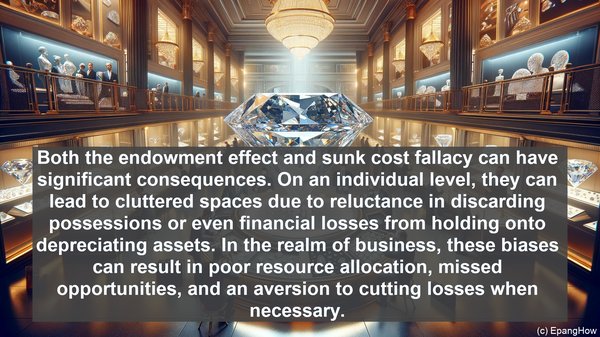Introduction: The Intricacies of Decision-Making
Hello, everyone! Welcome to our article on the endowment effect and sunk cost fallacy. Decision-making is a fundamental aspect of our lives, and it’s fascinating how our choices can be influenced by various factors, including cognitive biases. Today, we’ll be exploring two such biases that often lead us astray: the endowment effect and sunk cost fallacy.
Defining the Endowment Effect: The Value of Ownership
The endowment effect refers to our tendency to ascribe higher value to things we own compared to identical things we don’t. In other words, the mere act of owning something can make us perceive it as more valuable. This bias was first identified by behavioral economist Richard Thaler in the 1980s, and it has since been studied extensively.
Examples of the Endowment Effect in Everyday Life
The endowment effect manifests in various scenarios. For instance, have you ever hesitated to sell a possession, even when you rarely use it? That’s because you’ve assigned a higher value to it simply because it’s yours. Similarly, in negotiations, the party that already possesses an item often demands a higher price for it, based on the perceived value.

Understanding the Sunk Cost Fallacy: The Trap of Past Investments
Now, let’s shift our focus to the sunk cost fallacy. This bias revolves around our tendency to continue investing in something, be it time, money, or effort, simply because we’ve already invested in it. The rationale behind this is that we don’t want our prior investment to go to waste, even if it no longer makes sense to continue.

Recognizing the Sunk Cost Fallacy in Action
We encounter the sunk cost fallacy in numerous situations. Consider a person who’s halfway through a movie they’re not enjoying. Despite the dissatisfaction, they might choose to stay till the end, thinking, ‘I’ve already invested so much time.’ Or in business, a project that’s consistently underperforming might still receive funding because of the resources already allocated.
The Implications of These Biases: From Personal to Professional
Both the endowment effect and sunk cost fallacy can have significant consequences. On an individual level, they can lead to cluttered spaces due to reluctance in discarding possessions or even financial losses from holding onto depreciating assets. In the realm of business, these biases can result in poor resource allocation, missed opportunities, and an aversion to cutting losses when necessary.
Strategies to Mitigate the Influence of These Biases
While cognitive biases are deeply ingrained, there are ways to minimize their impact. For the endowment effect, one strategy is to create psychological distance by imagining the item as if it were owned by someone else. This can help in evaluating its true value objectively. As for the sunk cost fallacy, it’s crucial to focus on future costs and benefits rather than past investments.
